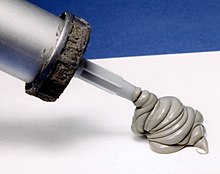
Back سيليكون (مركب كيميائي) Arabic Silicona AST Силикон Bulgarian Silikon BS Silicona Catalan Silikon Czech Silikone Danish Silikone German Σιλικόνη Greek Silikono EO

In organosilicon and polymer chemistry, a silicone or polysiloxane is a polymer composed of repeating units of siloxane (−O−R2Si−O−SiR2−, where R = organic group). They are typically colorless oils or rubber-like substances. Silicones are used in sealants, adhesives, lubricants, medicine, cooking utensils, thermal insulation, and electrical insulation. Some common forms include silicone oil, grease, rubber, resin, and caulk.[1][2]
Silicone is often confused with silicon, but they are distinct substances. Silicon is a chemical element, a hard dark-grey semiconducting metalloid, which in its crystalline form is used to make integrated circuits ("electronic chips") and solar cells. Silicones are compounds that contain silicon, carbon, hydrogen, oxygen, and perhaps other kinds of atoms as well, and have many very different physical and chemical properties.
- ^ Cite error: The named reference
Ullmannwas invoked but never defined (see the help page). - ^ Fink, Johannes Karl (5 July 2019). Liquid Silicone Rubber: Chemistry, Materials, and Processing. John Wiley & Sons. ISBN 9781119631378.